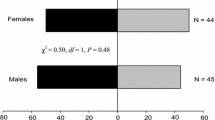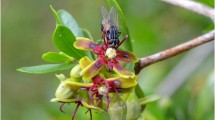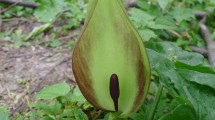Abstract
We studied the attraction of the African fruit chafer Pachnoda marginata Drury (Coleoptera: Scarabaeidae) to banana and 34 synthetic plant compounds previously shown to be detected by P. marginata olfactory receptor neurons. The behavioral studies were carried out in a two-choice olfactometer, where the attraction of beetles to lures and controls was monitored in 30-min intervals during whole days. Monitoring of the attraction over time gave additional information when comparing relative attractiveness of different compounds. Seventeen of the test compounds, primarily phenylic compounds, fruit esters, isovaleric acid, acetoin, and some floral or fruit terpenes, were attractive to P. marginata. Compounds showing no attractiveness included green leaf volatiles, lactones, and several alcohols, but also phenylic compounds and esters. One case of blend synergism was demonstrated, as well as some examples of sexual dimorphism in attraction. The significance of certain compounds and receptor neurons for olfactory-guided behavior of phytophagous scarabs is discussed.
Similar content being viewed by others
References
Arredondo-Bernal, H. C., Cibrián-Tovar, J., and Williams, R. N. 1995. Responses of Macrodactylus spp. (Coleoptera: Scarabaeidae) and other insects to food attractants in Tlaxcala and Jalisco, Mexico. Fl. Entomol. 78:56–61.
Barata, E. N., Mustaparta, H., Pickett, J. A., Wadhams, L. J., and Araujo, J. 2002. Encoding of host and non-host plant odors by receptor neurones in the eucalyptus woodborer, Phoracantha semipunctata (Coleoptera: Cerambycidae). J. Comp. Physiol. A 188:121–133.
Ben-Yakir, D., Bazar, A., and Chen, M. 1995. Attraction of Maladera matrida (Coleoptera: Scarabaeidae) to eugenol and other lures. J. Econ. Entomol. 88:415–420.
Blight, M. M., Pickett, J. A., Wadhams, L. J., and Woodcock, C. M. 1995. Antennal perception of oilseed rape, Brassica napus (Brassicaceae) volatiles by the cabbage seed weevil Ceutorhynchus assimilis (Coleoptera: Curculionidae). J. Chem. Ecol. 21:1649–1664.
Byers, J. A. 1995. Host tree chemistry affecting colonization in bark beetles, pp. 154-213, in R. T. Cardé and W. J. Bell (Eds.). Chemical Ecology of Insects 2. Chapman and Hall, New York.
de Bruyne, M., Clyne, P. J., and Carlson, J. R. 1999. Odor coding in a model olfactory organ: The Drosophila maxillary palp. J. Neurosci. 19:4520–4532.
de Bruyne, M., Foster, K., and Carlson, J. R. 2001. Odor coding in the Drosophila antenna. Neuron 30:537–552.
Domek, J. M. and Johnson, D. T. 1988. Demonstration of semiochemically induced aggregation of the green June beetle, Cotinis nitida (L.) (Coleoptera: Scarabaeidae). Environ. Entomol. 17:147–149.
Donaldson, J. M. I., McGovern, T. P., and Ladd, T. L., Jr. 1986. Trapping techniques and attractants for Cetoniinae and Rutelinae (Coleoptera: Scarabaeidae). J. Econ. Entomol. 79:374–377.
Donaldson, J. M. I., McGovern, T. P., and Ladd, T. L., Jr. 1990. Floral attractants for Cetoniinae and Rutelinae (Coleoptera: Scarabaeidae). J. Econ. Entomol. 83:1298–1305.
Fleming, W. E. 1972. Biology of the Japanese beetle. US Dep. Agric. Tech. Bull. 1449.
Hansson, B. S., Larsson, M. C., and Leal, W. S. 1999. Green leaf volatile-detecting olfactory receptor neurones display very high sensitivity and specificity in a scarab beetle. Physiol. Entomol. 24:121–126.
Harari, A. R., Ben-Yakir, D., and Rosen, D. 1994. Mechanism of aggregation behavior in Maladera matrida Argaman (Coleoptera: Scarabaeidae). J. Chem. Ecol. 20:361–371.
Heath, J. J., Williams, R. N., and Phelan, P. L. 2001. High light intensity: A critical factor in the wind-tunnel flight of two scarabs, the rose chafer and Japanese beetle. J. Chem. Ecol. 27:419–429.
Klein, M. G. and Edwards, D. C. 1989. Captures of Popillia lewisi (Coleoptera: Scarabaeidae) and other scarabs on Okinawa with Japanese beetle lures. J. Econ. Entomol. 82:101–103.
Knudsen, J. T., Tollsten, L., and Bergström, L. G. 1993. Floral scents—A checklist of volatile compounds isolated by head-space techniques. Phytochemistry 33:253–280.
Ladd, T. L. and McGovern, T. P. 1980. Japanese beetle: A superior attractant, Phenethyl propionate + Eugenol + Geraniol, 3:7:3. J. Econ. Entomol. 73:689–691.
Langford, G. S., Muma, M. H., and Cory, E. N. 1943. Attractiveness of certain plant constituents to the Japanese beetle. J. Econ. Entomol. 36:248–252.
Larsson, M. C., Leal, W. S., and Hansson, B. S. 2001. Olfactory receptor neurons detecting plant odors and male volatiles in Anomala cuprea beetles (Coleoptera: Scarabaeidae). J. Insect Physiol. 47:1065–1076.
Leal, W. S. 1991. (R,Z)-5-(−)-(Oct-1-enyl)oxacyclopentan-2-one, the sex pheromone of the scarab beetle Anomala cuprea. Naturwissenschaften 78:521–523.
Leal, W. S. 1998. Chemical ecology of phytophagous scarab beetles. Annu. Rev. Entomol. 43:39–61.
Leal, W. S., Ono, M., Hasegawa, M., and Sawada, M. 1994. Kairomone from dandelion, Taraxacum officinale, attractant for scarab beetle Anomala octiescostata. J. Chem. Ecol. 20:1697–1704.
Lin, H. and Phelan, P. L. 1991. Identification of food volatiles attractive to dusky sap beetle, Carpophilus lugubris (Coleoptera: Nitidulidae). J. Chem. Ecol. 17:1273–1286.
Loughrin, J. H., Potter, D. A., and Hamilton-Kemp, T. R. 1995. Volatile compounds induced by herbivory act as aggregation kairomones for the Japanese Beetle (Popillia japonica Newman). J. Chem. Ecol. 21:1457–1467.
Loughrin, J. H., Potter, D. A., and Hamilton-Kemp, T. R. 1998. Attraction of Japanese beetles (Coleoptera: Scarabaeidae) to host plant volatiles in field trapping experiments. Environ. Entomol. 27:395–400.
Loughrin, J. H., Potter, D. A., Hamilton-Kemp, T. R., and Byers, M. E., 1996a. Volatile compounds from Crabapple (Malus spp.) cultivars differing in susceptibility to the Japanese beetle (Popillia japonica Newman). J. Chem. Ecol. 22:1295–1305.
Loughrin, J. H., Potter, D. A., Hamilton-Kemp, T. R., and Byers, M. E., 1996b. Role of feeding-induced plant volatiles in aggregative behavior of the Japanese beetle (Coleoptera: Scarabaeidae). Environ. Entomol. 25:1188–1191.
Loughrin, J. G., Potter, D. A., Hamilton-Kemp, T. R., and Byers, M. E., 1997a. Response of Japanese Beetles (Coleoptera: Scarabaeidae) to leaf volatiles of susceptible and resistant maple species. Environ. Entomol. 26:334–342.
Loughrin, J. G., Potter, D. A., Hamilton-Kemp, T. R., and Byers, M. E., 1997b. Diurnal emission of volatile compounds by Japanese beetle-damaged grape leaves. Phytochemistry 45:919–923.
Metcalf, R. L. and Metcalf, E. R. 1992. Plant Kairomones in Insect Ecology and Control. Chapman and Hall, New York.
Nikonov, A. A., Peng, G., Tsurupa, G., and Leal, W. S. 2002. Unisex pheromone detectors and pheromone-binding proteins in scarab beetles. Chem. Senses 27:495–504.
Nout, M. J. R. and Bartelt, R. J. 1998. Attraction of a flying nitidulid (Carpophilus humeralis) to volatiles produced by yeasts grown on sweet corn and a corn-based medium. J. Chem. Ecol. 24:1217–1239.
Omura, H., Honda, K., and Hayashi, N. 2000. Identification of feeding attractants in oak sap for adults of two nymphalid butterflies, Kaniska canace and Vanessa indica. Physiol. Entomol. 25:281–287.
Peacock, L., Lewis, M., and Powers, S. 2001. Volatile compounds from Salix spp. varieties differing in their susceptibility to three willow beetle species. J. Chem. Ecol. 27:1943–1951.
Phelan, P. L. and Lin, H. C. 1991. Chemical characterization of fruit and fungal volatiles attractive to dried-fruit beetle, Carpophilus hemipterus (L.) (Coleoptera: Nitidulidae). J. Chem. Ecol. 17:1253–1272.
Potter, D. A. and Held, D. W. 1999. Absence of food-aversion learning by a polyphagous scarab, Popillia japonica, following intoxication by geranium, Pelargonium x hortorum. Entomol. Exp. Appl. 91:83–88.
Reinecke, A., Ruther, J., and Hilker, M., 2002a. The scent of food and defence: Green leaf volatiles and toluquinone as sex attractant mediate mate finding in the European cockchafer Melolontha melolontha. Ecol. Lett. 5:257–263.
Reinecke, A., Ruther, J., Tolasch, T., Francke, W., and Hilker, M., 2002b. Alcoholism in cockchafers: Orientation of male Melolontha melolontha towards green leaf alcohols. Naturwissenschaften 89:265–269.
Renwick, J. A. A. 1989. Chemical ecology of oviposition in phytophagous insects. Experientia 45:223–228.
Rigout, J. 1989. The Beetles of the World. Vol. 9: The Cetoniini. Science Nat., Venette.
Rochat, D., Nagnan-Le Meillour, P., Esteban-Duran, J. R., Malosse, C., Perthuis, B., Morin, J.-P., and Descoins, C., 2000b. Identification of pheromone synergists in American palm weevil, Rhynchophorus palmarum, and attraction of related Dynamis borassi. J. Chem. Ecol. 26:155–187.
Rochat, D., Ramirez-Lucas, P., Malosse, C., Rosa, A., Titus, K., and Morin, J. P., 2000a. Role of solid-phase microextraction in the identification of highly volatile pheromones of two Rhinoceros beetles Scapanes australis and Strategus aloes (Coleoptera: Scarabaeidae, Dynastinae). J. Chromatogr. A 885:433–444.
Ruther, J., Reinecke, A., and Hilker, M. 2002. Plant volatiles in the sexual communication of Melolontha hippocastani: Response towards time dependent bouquets and novel function of (Z)-3-hexen-1-ol as a sexual kairomone. Ecol. Entomol. 27:76–83.
Ruther, J., Reinecke, A., Thiemann, K., Tolasch, T., Francke, W., and Hilker, M. 2000. Mate finding in the forest cockchafer, Melolontha hippocastani, mediated by volatiles from plants and females. Physiol. Entomol. 25:172–179.
Schlyter, F. and Birgersson, G. A. 1999. Forest beetles, pp. 113-148, in J. Hardie and A. K. Minks (Eds.). Pheromones of Non-Lepidopteran Insects Associated with Agricultural Plants. CABI Publishing, Wallingford, United Kingdom.
Stensmyr, M. C., Larsson, M. C., Bice, S. B., and Hansson, B. S. 2001. Detection of fruit-and flower-emitted volatiles by olfactory receptor neurons in the polyphagous fruit chafer Pachnoda marginata (Coleoptera: Cetoniinae). J. Comp. Physiol. A 187:509–519.
Van der Pers, J. N. C. and Löfstedt, C. 1983. Continuous single sensillum recording as a detection method for moth pheromone components in the effluent of a gas chromatograph. Physiol. Entomol. 8:203–211.
Visser, J. H. and Avé, D. A. 1978. General green leaf volatiles in the olfactory orientation of the Colorado beetle, Leptinotarsa decemlineata. Entomol. Exp. Appl. 24:738–749.
Wadhams, L. J., Angst, M. E., and Blight, M. M. 1982. Responses of the olfactory receptors of Scolytus scolytus (F.) (Coleoptera: Scolytidae) to the stereoisomers of 4-methyl-3-heptanol. J. Chem. Ecol. 8:477–492.
Wibe, A., Borg-Karlsson, A.-K., Norin, T., and Mustaparta, H. 1997. Identification of plant volatiles activating single receptor neurons in the pine weevil (Hylobius abietis). J. Comp. Physiol. A 180:585–595.
Williams, R. N., McGovern, T., Klein, M. G., and Fickle, D. S. 1990. Rose chafer (Coleoptera: Scarabaeidae): Improved attractants for adults. J. Econ. Entomol. 83:111–116.
Williams, R. N. and Miller, K. V. 1982. Field assay to determine attractiveness of various aromatic compounds to rose chafer adults. J. Econ. Entomol. 75:196–198.
Yokomizo, K. and Nagata, K. 1984. Attractants for scarabaeid beetles. Shokobutsoeki 38:403-406. (in Japanese).
Author information
Authors and Affiliations
Corresponding author
Rights and permissions
About this article
Cite this article
Larsson, M.C., Stensmyr, M.C., Bice, S.B. et al. Attractiveness of Fruit and Flower Odorants Detected by Olfactory Receptor Neurons in the Fruit Chafer Pachnoda marginata . J Chem Ecol 29, 1253–1268 (2003). https://doi.org/10.1023/A:1023893926038
Issue Date:
DOI: https://doi.org/10.1023/A:1023893926038




